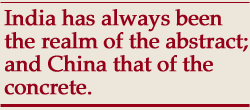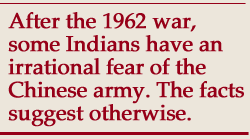The Rediff Special/Rajeev Srinivasan
If I were to take the long view of history, I would contend that 1962 was a relatively minor skirmish in the long-term civilizational competition between India and China for the domination of the Asian ethos.
The only significant difference now as compared to centuries ago is that for the first time in history, the buffer state of Tibet has disappeared and Chinese troops are on India's borders, and this means China can threaten India because it controls the headwaters of the Indus and the Brahmaputra, which arise in Tibet.
Yet, as far back as I can think, the two civilizations have been rivals in the grand scheme of events. There are distinct archetypes that drive the two. India has always been the realm of the abstract; and China that of the concrete. India is individualistic; China is collective. India is open and inclusive. China is closed and exclusive.
It is interesting to compare the results of this rivalry on the rest of Asia. It should be remembered that there was substantial out-migration from China, whereas there was very little from India towards the Asian hinterland, except for an occasional foray by an emperor or two, which probably only resulted in small population movements.
The impact of Indian ideas can be seen everywhere: in languages, rituals, architecture, art, mythology, religion, as far east as Cambodia and Vietnam. Chinese cuisine and scripts, especially in East Asia, industrial arts, and agriculture have been China's legacy in its periphery. It would appear that India has been more successful in exporting its civilization peacefully, strictly through the force of its ideas.
 Where China has bypassed India is in areas where the collective will is important: for instance in huge projects, such as the Great Wall, the infrastructure projects today, and in manufacturing world-class sportsmen/women. India, with fractious individualism and vested-interest politics, is succeeding in areas where there is a greater need for individual creativity, such as entertainment and R&D.
Where China has bypassed India is in areas where the collective will is important: for instance in huge projects, such as the Great Wall, the infrastructure projects today, and in manufacturing world-class sportsmen/women. India, with fractious individualism and vested-interest politics, is succeeding in areas where there is a greater need for individual creativity, such as entertainment and R&D.
To forecast their future trajectories, it is necessary to look back at the past. It is a little-known but stunning fact that up until 1750 CE the four greatest manufacturing centres in the world were in India and China: the Brahmaputra and Kaveri deltas and the Pearl River and Yangtze deltas, respectively. Together, the two Asian behemoths accounted for roughly 60 per cent of the entire manufactured goods in the world before colonialism ruined both.
This fact is astonishing to most Indians, who do not realize how advanced India was in industry at that time: India had world-beating skills in areas such as specialty metals, for instance the so-called Damascene steels. Given the natural and human resources of both the Asian nations, it is only fitting that they will become the leaders in industry once again. Some forecasters contend that their combined share of world manufacturing will overtake that of Europe well before 2050.
The trend in China is already clear: they are world leaders in small-scale manufacturing, toys, clothing, traditional medicines, and increasingly in white goods and electronics. But it is worth considering that India too has nascent clusters of excellence: in business process outsourcing, in medical services, in gemstones and jewellery, in small machine tools, in educational services, in video/advertising and entertainment, in space applications, and in agriculture and related food processing.
Incidentally, services are 'sticky': that is, since they depend on human resources, once services are outsourced to a country, they tend to remain there, because the labour is not mobile. This is a sustainable competitive advantage for India as compared to China, for manufacturing is not sticky: as labour costs increase in China, the factories can be relocated to even lower-cost locations like Vietnam or Myanmar. So India could be to services what China has been to small-scale manufacturing.
There are other myths about Chinese invincibility that Indians need to disabuse themselves of. After the 1962 war, some Indians have an irrational fear of the Chinese army. The facts suggest otherwise.
According to Ashley Tellis of the Rand Corporation, Indian capability in 2002 is much greater than in 1962, when India was totally unprepared. Tellis contends that there is a rough military balance in the Himalayas along the India-Tibet border.
It is worth remembering that in 1979 or so, the Chinese invaded Vietnam to 'teach them a lesson' (and timed it to mock Vajpayee, who was on a visit to China as foreign minister at the time). However, the small but battle-hardened Vietnamese Army thrashed the Chinese, forcing them to retreat with massive casualties. In the 1962 war, Indian soldiers showed great courage in repulsing vastly larger numbers of the enemy: for instance, there is the heroic story of the Charlie Company, 13th Battalion, Kumaon Regiment, at Rezang La in Chushul, Ladakh. A mere 114 Indian soldiers accounted for perhaps a thousand Chinese.
The Indian Navy, with its blue water capability, is ahead of the Chinese. It is only in nuclear weapons and missile systems that China has a significant advantage over India. And of course, in the fact that they, quite happily, proliferate these technologies to all sorts of unsavoury elements as part of the creation of a Sino-Islamic axis as a counterweight to Euro-American power plays.
Nevertheless, in general, the two cultures have unconsciously followed their true natures.
 Chinese practise exclusivism: they think they are superior to everyone else -- the Middle Kingdom -- and all others are barbarians. They have manufactured memories of a mythical Golden Age, although, with much of its land being non-arable and flood-prone, China has always led a generally hand-to-mouth existence: hence their massive out-migration. And they have the more recent memories of colonial humiliation; which makes them exactly like the Nazis between the two World Wars: really dangerous.
Chinese practise exclusivism: they think they are superior to everyone else -- the Middle Kingdom -- and all others are barbarians. They have manufactured memories of a mythical Golden Age, although, with much of its land being non-arable and flood-prone, China has always led a generally hand-to-mouth existence: hence their massive out-migration. And they have the more recent memories of colonial humiliation; which makes them exactly like the Nazis between the two World Wars: really dangerous.
Indians practise inclusivism, accepting outside influences. India tolerates diversity, and accepts refugees from anywhere. Not for India the type of Han monoculture that China aspires to create. In the process, China loses diversity; for instance, by destroying Tibetan culture, China has lost whatever treasures Tibet could have given the world. India is so diverse that today the majority Hindus find themselves besieged, as the State goes into overdrive to protect minority interests.
After World War II, both nations came up with interesting models. Both were active in working with other post-colonial states. India started believing its own propaganda about how a motley crew of impoverished and tiny nations could provide an alternative to the bipolar world of the Soviet Union and the United States. In reality, the ragtag Third World, consisting as it does mostly of banana republics, could not, and did not, have much impact on the rest of the world.
The tragedy for India was that it internalized a self-image of a banana republic. Of course, a super banana republic, led by redoubtable statesmen such as J Nehru and K Menon, but a banana republic nevertheless. This is nonsensical, because India, by way of its natural resources, population and civilization, is a great power that once was and will be again.
China, on the other hand, was careful: they let it be known that they were an incipient superpower, one 'friendly' to the needs of all the downtrodden nations of the world ('poor countries of the world unite, you have nothing to lose but your chains', or words to that effect). They kept their distance from all those meaningless Non-Aligned Movement palavers and their holding of hands and frequent singing of kumbaya.
 Instead, the Chinese realized at some point that economics was key, and they set about reforming their economic policies. There are fundamental economic problems, for instance the very large non-performing assets of banks, but, as seen during the drama of the latest regime change in China, there is a consensus on supporting entrepreneurship and capitalism, in an effort to become an economic superpower.
Instead, the Chinese realized at some point that economics was key, and they set about reforming their economic policies. There are fundamental economic problems, for instance the very large non-performing assets of banks, but, as seen during the drama of the latest regime change in China, there is a consensus on supporting entrepreneurship and capitalism, in an effort to become an economic superpower.
But China has a major problem coming up: the necessary transition from a totalitarian political entity to a democratic one. Other East Asian states, notably South Korea and Singapore, have provided political rights only after their economies took off. Whether the continent-sized state of China can do this remains to be seen. Of course, there continue to be simmering problems with what could be called the Han Empire: the restive areas of Xinjiang and Tibet continue to wish to secede.
India, on the other hand, has set its polity on the right path first by offering genuine mechanisms for democratic input. Alas, this has resulted in the abomination of democracy in the country. There may also be a 'democracy penalty' that is holding India back from reaching its economic potential. Be that as it may, India is making efforts to turbo-charge its economy to reach the 8 per cent growth that it needs: the privatization activity, the major highway projects (eg the Golden Quadrilateral), the freeing of sectors like IT and biotech from intrusive government intervention.
China has a certain advantage over India based on its totalitarian power structure. The country has always thrived when there was a strong imperial centre. What worked in the age of Chinese empires is now working again for them, for the new Communist emperors (Mao, Deng) have been able to get them all moving in the same direction.
And this strong centre has adopted Sun Tzu's tactics of stealthy warfare: by proxy and through missionaries. Thus China contains India through its proxy Pakistan and its fifth columnists, the Marxists of India.
Instead of responding with a Chanakyan tactic of flanking attacks, India has dithered. To begin with, it had na´ve leaders, mediocre yes-men and personality cults; today, it has too many people in the bureaucracy, the intelligentsia and in politics who are in effect agents of the Chinese. It is unbelievable that the Indian State has not punished the Chinese for adventurism, for instance by proliferating to Taiwan, Japan, or Vietnam, just as China has proliferated nuclear weapons and missiles to North Korea and Pakistan.
But both civilizations have suffered from poor-quality leadership, whereas the individual citizens have generally excelled at carrying on their normal business. Leadership is at a premium. Because of the opaque, Forbidden City nature of Chinese politics, it is hard for the average China watcher to understand how competent a Hu Jintao is going to be. On the other hand, because of the wide-open nature of Indian politics, it can be seen that almost all of the politicians in the country are venal.
On average, both these nations are improving the lot of their teeming populations. But while India extended the hand of friendship to China, the latter reciprocated with flowery speeches and promises of peaceful co-existence while at the same time using its proxies to encircle and contain India.
But with an emerging feeling among the ASEAN and East Asia about needing a counterbalance to an increasingly imperialistic China, India's ability to police the oil tanker routes in the Indian Ocean, and the Chinese recognition of a backlash from its axis with Muslim nations, a different dynamic is emerging. India might make a game out of it, after all.
(Rajeev Srinivasan, a rediff.com columnist, writes frequently on China. His interests are the strategic and economic aspects of China's development.)
